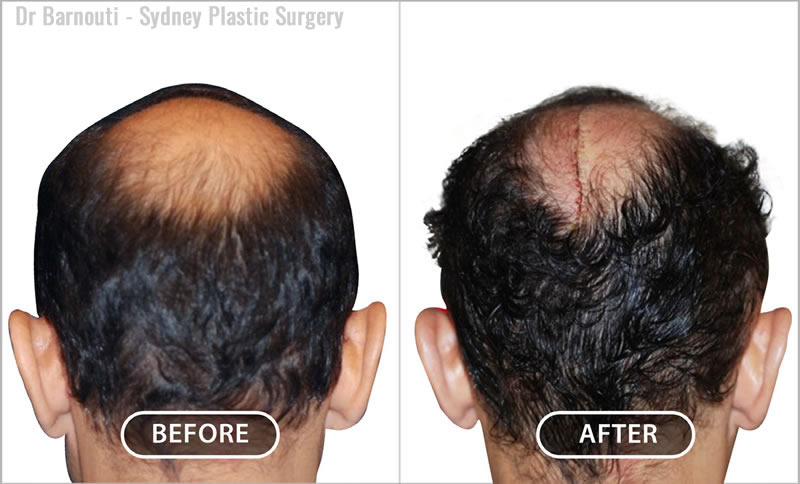Scalp Reduction Surgery
Scalp reduction surgery is a surgical procedure designed to treat a variety of scalp conditions, including those resulting in excessive skin laxity, scarring, or cosmetic concerns. The surgery involves the removal of a portion of the scalp skin, followed by the stretching of the remaining skin to close the defect. This technique is used for individuals experiencing hair loss from conditions such as alopecia. Other indications are scar tissue from burns, or congenital scalp deformities. Patients suffering from certain dermatological disorders, such as Cutis Verticis Gyrata (CVG), where excess skin folds on the scalp will also benefit from scalp reduction.
While scalp reduction surgery is not as common as other hair restoration techniques, it remains a valuable option for certain patients, especially when other treatments have failed or are not suitable.
Scalp Reduction
Before After Photos
The primary indications for scalp reduction surgery include:
- Alopecia (Hair Loss)
Male Pattern Baldness (MPB): Scalp reduction surgery can be considered in severe cases of androgenetic alopecia (male pattern baldness), especially when the hair loss is extensive and the patient has significant areas of baldness. It involves removing the bald area and advancing the remaining healthy hair-bearing scalp to cover the defect.
Female Pattern Baldness (FPB): Although less common, women with significant hair loss who have extensive thinning over the crown or scalp may also be candidates for scalp reduction, though hair transplant may be the first option for many.
- Cutis Verticis Gyrata (CVG)
In Cutis Verticis Gyrata (CVG), a condition characterized by the presence of deep furrows and folds of skin on the scalp, surgical intervention may be necessary when the condition is severe or causing significant cosmetic distress. CVG can cause discomfort, hair loss, and psychosocial concerns, and when conservative measures fail, scalp reduction can help alleviate these issues by removing the thickened, wrinkled skin and smoothing the scalp.
- Scalp Deformities or Scarring
Scarring Alopecia: Conditions that cause permanent hair loss due to scarring, such as cicatricial alopecia or scarring from trauma, burns, or surgeries, can lead to large areas of scar tissue that cannot be treated with hair restoration methods like medication or transplants. Scalp reduction surgery can be used to remove the affected skin and improve the appearance of the scalp.
Trauma or Burns: Scalp reductions are sometimes employed in patients who have suffered from severe burns or scalp trauma, especially when the skin has tightened or contracted, limiting mobility or hair regrowth. The procedure can reduce tight, scarred skin and restore a more natural appearance.
- Congenital or Developmental Scalp Issues
Some individuals are born with congenital scalp conditions that cause irregularities in the skin or hair growth. Conditions like plagiocephaly (misshapen skull) or congenital alopecia may benefit from scalp reduction if they result in significant cosmetic concerns or functional issues, such as discomfort or scalp tightness.
The Scalp Reduction Procedure
The goal of scalp reduction surgery is to remove areas of the scalp with minimal hair growth and replace them with areas that still contain healthy hair. Here is an overview of how the procedure typically works:
- Preoperative Assessment
Consultation: Before surgery, patients undergo a thorough consultation with a plastic surgeon. During this consultation, the surgeon will assess the condition of the scalp, the extent of hair loss or scarring, and the patient’s overall health.
Imaging and Planning: The surgeon will often create a detailed plan for the procedure, including measurements of the area to be removed, and may use photographs or scalp imaging to aid in the process.
- Anesthesia
Scalp reduction can be performed under local anesthesia with sedation, or under full anesthesia especially if the procedure is extensive or if the patient prefers to be asleep.
- Incision and Skin Removal
The surgeon marks the area of the scalp to be excised. Once the area is anesthetized, a scalpel is used to make a series of incisions along the designated lines. Depending on the extent of the scalp that needs to be removed, the incision may be large or small.
After the excision, the remaining skin is stretched to cover the defect. This step may require some tissue expansion, especially when the skin is tight or scarred.
- Closing the Wound
The incisions are carefully closed with sutures or staples, and in some cases, the scalp may need to be “tightened” to ensure proper healing. The surgeon will aim for a natural appearance, ensuring the new hairline or scalp contour is as aesthetically pleasing as possible.
- Postoperative Care
After surgery, patients are given instructions for wound care, including how to clean and dress the incision sites. Swelling and mild discomfort are common in the days following surgery, but these typically subside within a few days.
Bandages are often placed over the scalp to help with the healing process, and patients may be asked to refrain from strenuous activities for one week.
Risks and Considerations
As with any surgical procedure, scalp reduction surgery carries some risks. It is essential to be aware of potential complications, including:
Infection: As with any surgery, there is a risk of infection, which can be minimized by following postoperative care instructions and keeping the incision site clean.
Scarring: While scalp reduction surgery aims to minimize visible scarring, there is always a risk of noticeable or keloidal scars, especially in patients prone to abnormal scarring.
Hairline Irregularities: In some cases, the new hairline or scalp contour may appear unnatural if the surgery is not carefully planned. Surgeons with experience in aesthetic scalp surgery can help reduce this risk.
Poor Healing: In certain cases, the scalp may not heal properly, leading to issues like wound dehiscence (wound opening) or skin necrosis (death of skin tissue).
Hair Growth: Although scalp reduction can help to restore a more natural appearance to the scalp, it may not necessarily encourage new hair growth in the treated areas. For some individuals, additional hair restoration techniques, such as hair transplants, may be necessary.
Alternatives to Scalp Reduction Surgery
Scalp reduction surgery is often considered when other hair restoration methods are not feasible or have been unsuccessful. However, there are several alternatives that may be appropriate depending on the patient’s condition:
Hair Transplantation: This procedure involves transplanting hair follicles from one area of the scalp to another, typically from areas of thick hair to bald or thinning areas.
Tissue Expansion: This involves gradually stretching the scalp skin to create additional skin for closure, which can be used for patients with significant scarring or hair loss.
Conclusion
Scalp reduction surgery is a viable option for certain patients seeking to address extensive hair loss, scarring, or cosmetic concerns related to the scalp. It is particularly effective for patients with severe alopecia, CVG, scarring alopecia, or trauma-induced scalp deformities. While the procedure can provide significant aesthetic improvement, it is essential for patients to fully understand the risks, recovery process, and potential for scarring before making a decision.
A detailed consultation with a qualified Plastic surgeon is critical to determine whether scalp reduction is the best treatment option and to develop an individualized plan that addresses both functional and cosmetic goals.
Planning Your Surgery
The Consultation
During the consultation, Dr. Barnouti will discuss your desired changes in appearance and explain the different options available to you, the procedure itself, and its risks and limitations.
Dr Barnouti may also take “before” photos, and give you detailed instructions to prepare for surgery, including guidelines for eating and drinking, smoking and taking or avoiding vitamins, supplements and medications.
Be sure to tell your surgeon if you have had previous hair restoration surgery if you smoke, or if you take any drugs or medications (including aspirin). Also, inform your doctor if you have a tendency to form large scars or keloids.
Take this opportunity to ask all the questions you have about the surgery and to see photos of recent patients before and after surgery.
The surgery
Scalp reduction (permanent solution)
Scalp reduction is usually performed using a local anaesthetic with sedative or general anaesthetics . Usually, a portion of the scalp, two to five centimetres wide, can be removed in one session, and the remaining skin is then stitched back together. Newer techniques of scalp reduction may also be used: these include scalp expansion and scalp extension, which are explained below.
Scalp expansion (permanent solution)
With a scalp expansion, balloon-like devices called tissue expanders are implanted under the sides and back of the scalp where the hair is still growing. These are gradually inflated over a four—to twelve-week period, resulting in an increase in the amount of loose hair-bearing tissue as the skin stretches. The following scalp reduction surgery produces more loose bald skin than would be possible if it had not been stretched before surgery.
Scalp extension (also known as Frechet Extender).
Scalp extension involves using a surgical device made of two rows of hooks linked by elastic bands. This device is placed on the scalp’s surface during the first scalp reduction procedure. Over a one-month period, the tension in the bands gets tighter, constantly and gently pulling upwards on the hair-bearing tissues. This loosens and stretches the scalp, allowing for another, and normally greater, scalp reduction to be done.
With scalp extension, a faster series of scalp reductions can be completed within a 30—to 90–day period. In the past, some scalps could not be reduced at all, and those that could be reduced often took a year or longer for the procedures to be accomplished. The treatment is much quicker now!
Scalp extension has some of the benefits of scalp expansion; however, it causes less discomfort and deformity. However, the amount of tissue stretch is generally less than can be achieved with scalp expansion devices.
What are the risks associated with this procedure?
Plastic surgery, like any surgical procedure, carries inherent risks and potential complications.
Please read our Risks and Complications of Plastic Surgery page.
After Surgery
Patients usually experience swelling and numbness for the first few days following the procedure. Because the skin needs time to soften, tightness in the scalp is also common for several months after the operation. You will be going home on the same day, and the wound on the scalp does not require dressing after the procedure.
The scalp will remain numb for 12-24 hours, following that you will need simple analgesia.
A follow up appointment will be arranged in 7-10 days after surgery.
You will need to avoid sun exposure for a week and any strenuous work that may increase your blood pressure.
Getting you back to work and normal activities
You should be able to resume normal daily activities over the next several days slowly.
Shampooing and gentle combing can be started next day.
Most patients can return to work within 5-7 days following the procedure.
Strenuous activity must be kept to a minimum for 7-10 days.
Most patients who decide to undergo scalp reduction are satisfied with the results.
While there may be particular scarring around the incision, it is usually covered by hair. A hair transplant procedure can better cover the scars.
Call us on free phone 1300 002 006 if you are outside Sydney or 9561 0222 if you’re in the Sydney area


